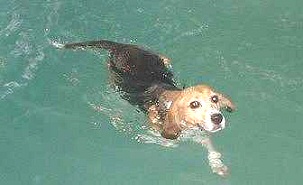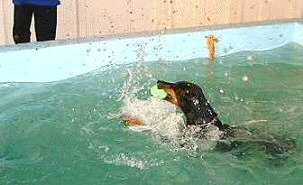Canine and Equine Hydrotherapy
In medical/veterinary terms, Hydrotherapy is taken to mean the treatment of disease by, or in, water. In its simplest form this could be bathing your animal using a commercially available herbal shampoo or using a stronger, medicated wash which has been prescribed by your vet to treat a specific skin condition.
However the commonest form of hydrotherapy, and most fun for animal and owner alike, is...

Swimming your dog!
This is a form of rehabilitation therapy particularly appropriate for dogs and horses recovering from a range of conditions - especially those involving problems with limbs. All animals can swim by instinct. How much they enjoy it depends on their confidence in the water and this can be increased by gradual acclimatisation.
The Benefits of Hydrotherapy
Swimming helps to improve general fitness and stamina, improves muscle tone and is helpful in recovering from injury or operation. Muscle wastage begins within 3 days of any immobilisation so to prevent further weakness or injury it is important to rebuild, through safe exercise, any muscles that have deteriorated. It is better to swim dogs in heated water since cold water causes constriction of the blood vessels near the skin and to the superficial muscles (those just under the skin) which restricts the flow of blood making the muscles less efficient. However horses are usually swum in cold water because it helps to dissipate the enormous amounts of heat they generate under exertion - far more than dogs - with a less efficient cooling system. Therefore you are more likely to find heated pools for dogs and cold water pools for horses.
Exercise without stresses
Swimming is an excellent form of exercise because most of the muscles normally used in movement are involved - without the stresses caused by running on hard ground. On land, each footfall creates a shock wave which travels up the limb and is absorbed by bones, tendons and joints. While these stresses are necessary to maintain healthy, strong bone (see the section below the photographs) if severe, or repetitive, these shock waves can actually damage or weaken the limb, particularly an arthritic joint or one recovering from an injury or surgery. Hydrotherapy allows the "working out" and strengthening of the muscles while avoiding this potentially damaging concussion. Also, because of the increased resistance to movement, the muscles have to work harder than they would do on land.
Cardiovascular workout
Lungs
Under water, the chest is under pressure from the weight of the water squeezing inwards. This means that every breath requires more effort - the muscles used, particularly in breathing in, have to work harder (try breathing while someone sits on your chest). As any muscle strengthens with exercise, this improves the whole respiratory system.
Heart
The heart has to work harder in order to meet the increased demand for nutrients by all the muscles which are being worked.
If all this sounds like hard work - it is - that's the idea! For a dog, a 5 minute swim is equivalent to about a 5 mile run, whilst for a horse, 10 minutes swimming is equivalent to about an hours schooling! But the natural buoyancy of the water and the fact that sudden twists, stops and falls are impossible makes hydrotherapy a safe and effective form of exercise for a horse or dog. It's also very enjoyable for most animals... look at these two swimming in a pool 6 feet deep...
 "Err... how deep did you say this was?"
"Err... how deep did you say this was?" "I'm not bothered how deep, I'm having fun with my squeaky green toy!"
"I'm not bothered how deep, I'm having fun with my squeaky green toy!"
Hydrotherapy fittening program
Many racehorse trainers and dog trainers use swimming therapy as a regular part of their animals' fittening regime and have purpose built pools on their premises so that they can swim their animals regularly. However all effective training programs must contain the elements of stress that the animal is likely to face in competition. That is why, for example, showjumpers must practice jumping as well as improving their general fitness in terms of the cardiovascular and respiratory system. This is because bones are living tissue and adapt - "remodel" - in response to exercise. It is necessary to tell the bone where the areas of stress are going to be so that it can remodel and strengthen in preparation for "the event". This is why hydrotherapy should not be used on its own - swimming strengthens muscle but does little or nothing for bone. Your animal must also have normal exercise on land in order to keep their bones strong.
Get veterinary advice before swimming your dog or horse
Most dogs and horses will cope quite happily with swimming as a form of exercise therapy. However in the case of an old or unfit animal, or one recovering from an injury or surgery you must get advice from your vet before taking it swimming. If in any doubt at all - ASK YOUR VET!
